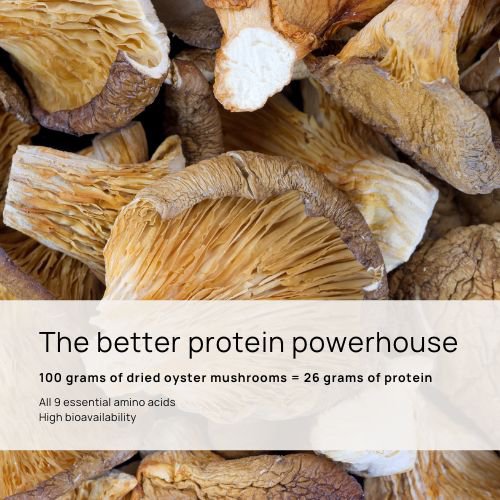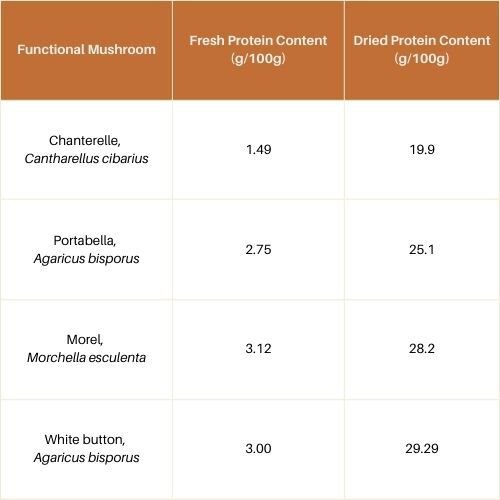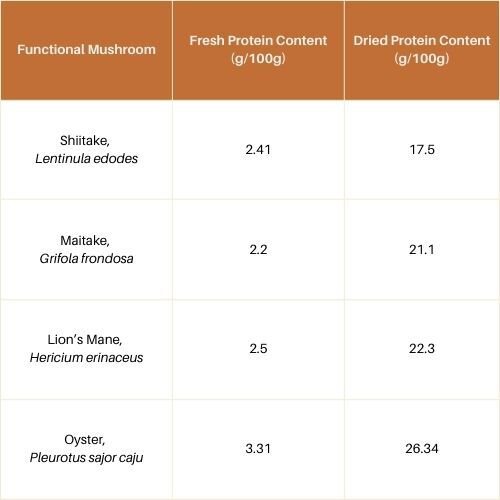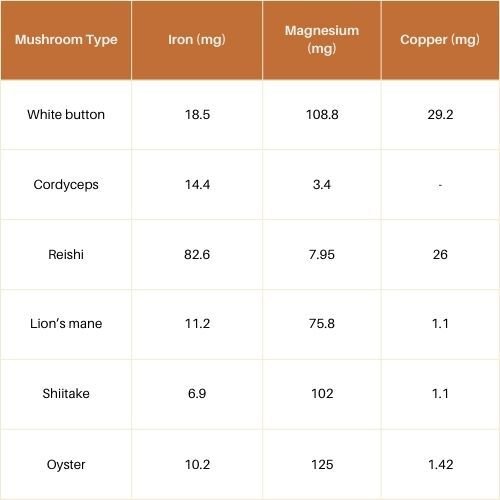Menu


Are mushrooms high in protein? How much protein are in mushrooms? These are questions you’d want to ask to ensure you’re making an informed choice about using culinary mushrooms.
In short, yes, raw mushrooms contain proteins, vitamins, and minerals. They are filled with high-quality protein and hidden treasures that can transform your health.
In fact, they are a complete protein source, meaning they have all the nine essential amino acids needed to boost human nutrition. If you eat mushrooms regularly, you’ll be happy to know that mushrooms contain more than just protein and offer a wide range of health benefits.
Discover the true potential of this nutritional powerhouse and learn the nutrient contents of mushrooms, how they contribute to your wellness, and ways to incorporate mushrooms into your meals.

Around 100 g of fresh mushrooms contain an average of 2.9 g of protein, which is quite low compared to animal-based proteins like chicken breast (which contains 32.1 g in a 100 g serving) [1,2]. Dried mushrooms, however, contain more protein than fresh mushrooms.
Dried mushrooms contain surprising amounts of protein that rival animal-based sources. For example, dried white button mushrooms, Agaricus bisporus, have 29.9 g of protein for every 100 g compared to 32.1 g in chicken breast [5].
Research conducted on Amanita zambiana showed that the protein content increased significantly after drying from 2.1 g of protein to 24.1 g per 100 g [3].
It’s surprisingly much higher than the protein content in some plant-based proteins, such as lentils (100 g of lentils contain 9 g of protein) and closer to that of animal-based sources [4].
Protein Intake Tips: The daily recommended intake of protein is 0.36 g for every pound, which translates to about 50 g for someone weighing 140 pounds [6].
The table below lists the protein content of dried functional mushrooms, from low to high, and compares the amount to that of fresh mushrooms. (Note that there is 32.1 g of protein in 100 g of chicken breast.)

Among these functional mushrooms, morel has the highest protein content when fresh. Oyster mushrooms, on the other hand, contain the highest fresh and dried protein content compared to other functional mushrooms, as shown in the table below.

Meeting the recommended intake of protein with mushrooms alone could be challenging as you’d need to consume a large portion of mushrooms.
For example, if your recommended intake is 50 g, you need to eat at least 1700 g of fresh mushrooms or take 167 g of dried mushroom powder. To ensure a balanced diet, it’s ideal to incorporate other sources of protein in your diet than relying on mushrooms alone.
Though fresh mushrooms have lower protein content than animal-based foods, they make up for in their protein quality. Mushroom proteins are high quality and have a high bioavailability.
The quality of a protein refers to its ability to provide the nine essential amino acids the human body requires for nutrition, which are as follows:
The quality of a protein is measured by the protein’s bioavailability, which is the extent and rate at which nutrients are absorbed, digested, and used by the body. Mushroom protein has a high bioavailability that rivals the quality of animal-based protein sources, unlike other plant-based foods, like rice and wheat.
A higher bioavailability means that the body utilizes proteins from mushrooms more efficiently for tissue growth, repair, and maintenance.
Studies on amanita mushrooms showed that their protein digestibility is very high [15]. In addition, their amino acid content is comparable to that of an egg white, and their bioavailability surpasses that of wheat and soybean.

Mushrooms contain both simple and complex carbohydrates, which are beneficial to digestive health. The average carbohydrate content of mushrooms is 4 g, about 1% of the DV intake [1]. This makes them an excellent ingredient for keto and weight-loss diets.
Simple carbohydrates, such as glucose and fructose, are converted into energy, which fuels the body’s activities. Complex carbohydrates are absorbed gradually into the digestive system, which keeps blood sugar levels in check and promotes feelings of fullness and satiety.
A study conducted with protein-matched amounts of meat and Agaricus bisporus showed that consuming mushrooms was more satiating than eating meat [16]. Participants who consumed 226 g of mushrooms for breakfast reported decreased hunger and greater fullness than those who had 28 g of meat. This is just another example of why mushrooms make an ideal meat substitute.
Mushrooms contain dietary fibers, such as chitin, that are not present in animal-based proteins. They also contains beta-glucans that posses impressive health benefits.
Chitin is an insoluble fiber unique to mushrooms that helps maintain its structure and bulk. When consumed, it aids in digestion and supports bowel movement.
Edible mushrooms are also a rich source of beta-glucans [17], a soluble fiber that has many health benefits, including:
Examples of mushrooms rich in beta-glucans include:
“The more whole, plant-based foods we eat, the better our health outcomes. So, let's make mushrooms a staple in our diets for their delicious flavor and impressive health benefits.” - Michael Greger, American physician, best known for his advocacy of a whole-food, plant-based diet.
Mushrooms contain various essential vitamins, minerals, and antioxidants [10]. Some key vitamins and minerals found in mushrooms include the following:
Mushrooms can be a great source of B vitamins, particularly B2 (riboflavin), B3 (niacin), B5 (pantothenic acid), and B6 (pyridoxine). These B vitamins play an important role in maintaining healthy skin, nervous system, and metabolism.
Oyster mushrooms have the highest niacin (vitamin B3) content at 31% of the DV intake [14].
Edible mushrooms are one of the few non-animal sources of Vitamin D, also known as the "sunshine vitamin." When mushrooms are exposed to sunlight, they synthesize vitamin D, which helps regulate calcium levels in the body and maintain strong bones [18].
Wild funnel chanterelles have the highest vitamin D content at 21.1 mcg/100 g [18].
While not as high in Vitamin C as some other fruits and vegetables, mushrooms still provide a small amount of this antioxidant, which supports a healthy immune system.
Calcium helps maintain strong bones and teeth while also promoting proper muscle and nerve function. A 100 g serving of white button mushrooms contains approximately 5 mg of calcium, which is 2% of the recommended daily intake (RDI).
This mineral is essential for regulating muscle, nerve function, and blood sugars. Chanterelle mushrooms contain a significant amount of 220 mg of magnesium, which is approximately 50% of the RDI [18].
Nutritional Value of Mushrooms: Aside from calcium and magnesium, edible mushrooms also contain other essential minerals, such as potassium, copper, iron, selenium, and phosphorus.
The table below compares the mineral content in a 100 g serving among six different mushrooms.

Although they may seem unassuming, edible varieties of farmed and wild mushrooms pack a nutritional punch, unlike any other foods. These mushrooms are among the best protein foods you can try to supplement a healthy diet.
While getting mushroom protein from cooked mushrooms is a viable way to boost the nutritional value of your meals, it’s not at all realistic to stick to a solely mushroom protein diet. Thankfully, mushroom supplements are a convenient way to incorporate the health benefits and nutritional content of mushrooms into your diet.
Mushroom supplements can be added to various dishes, such as soups, smoothies, and sauces, and even make a cup of coffee.
Real Mushrooms have exactly what you need to unlock these nutritional benefits. We have over ten capsules and powders made from organic mushrooms from high-quality growers in China, including:
Our products are made from the fruiting bodies of certified organic mushrooms, which means they have no mycelium or grain fillers.
“This is the only brand that I have found that actually uses real mushrooms and not mycelium. The real mushroom is where the good stuff is!” - Donna
What’s more, we use the dual-extraction method to ensure both soluble and insoluble fibers are collected from the mushrooms. This ensures our products have the highest nutrient profiles with over 25% beta-glucans.
Visit our shop to buy any of our products and embrace the health benefits of functional mushroom extracts for your own health and your pet’s health too.

Disclaimer: The information or products mentioned in this article are provided as information resources only, and are not to be used or relied on to diagnose, treat, cure, or prevent any disease. This information does not create any patient-doctor relationship, and should not be used as a substitute for professional diagnosis and treatment. The information is intended for health care professionals only. The statements made in this article have not been evaluated by the Food and Drug Administration. Any products mentioned are not intended to diagnose, treat, cure, or prevent any disease. The information in this article is intended for educational purposes. The information is not intended to replace medical advice offered by licensed medical physicians. Please consult your doctor or health practitioner for any medical advice.